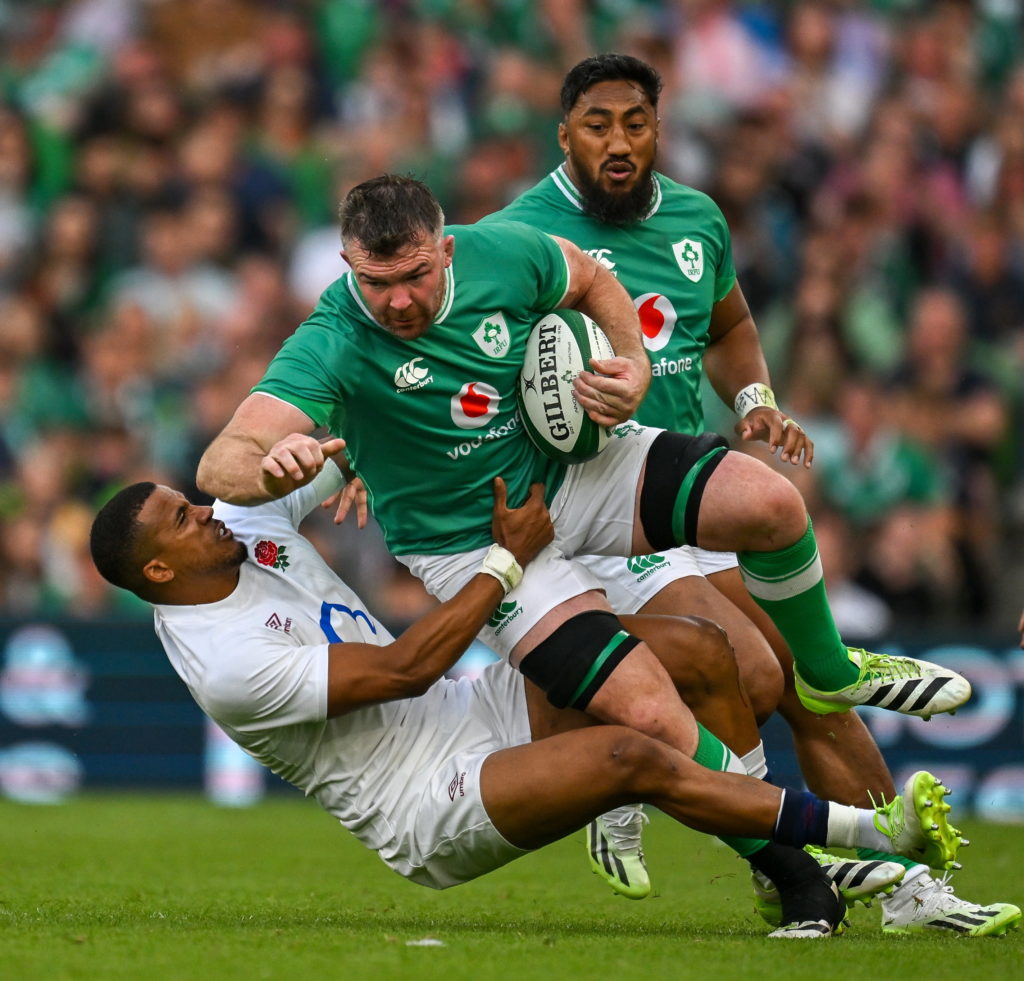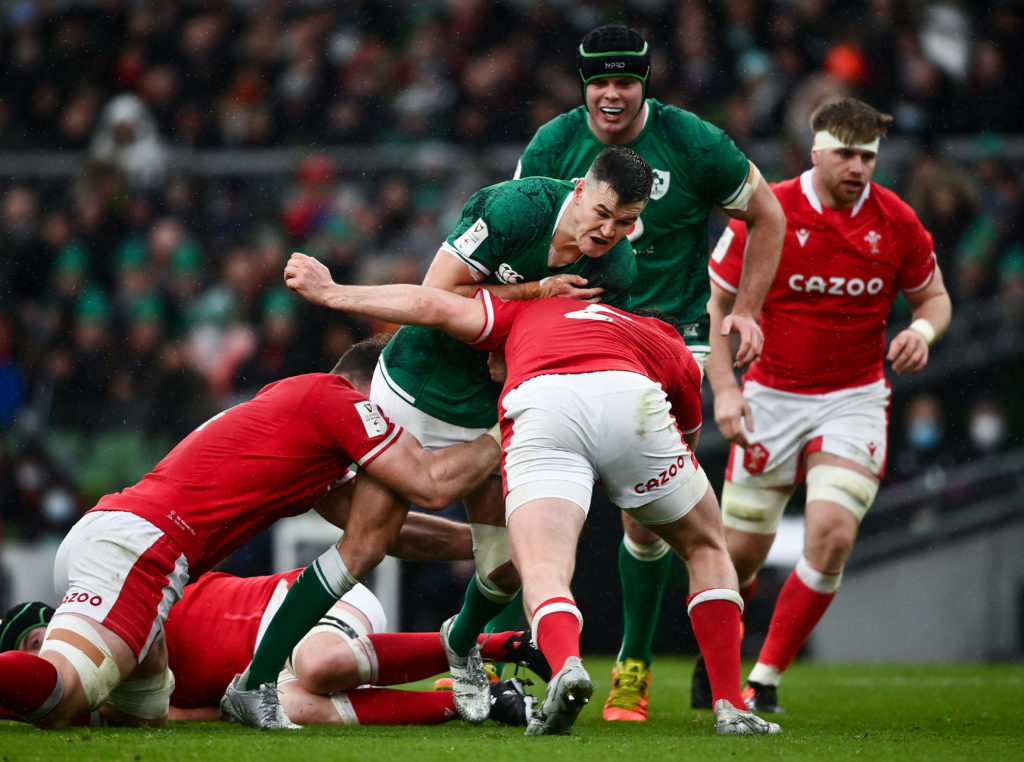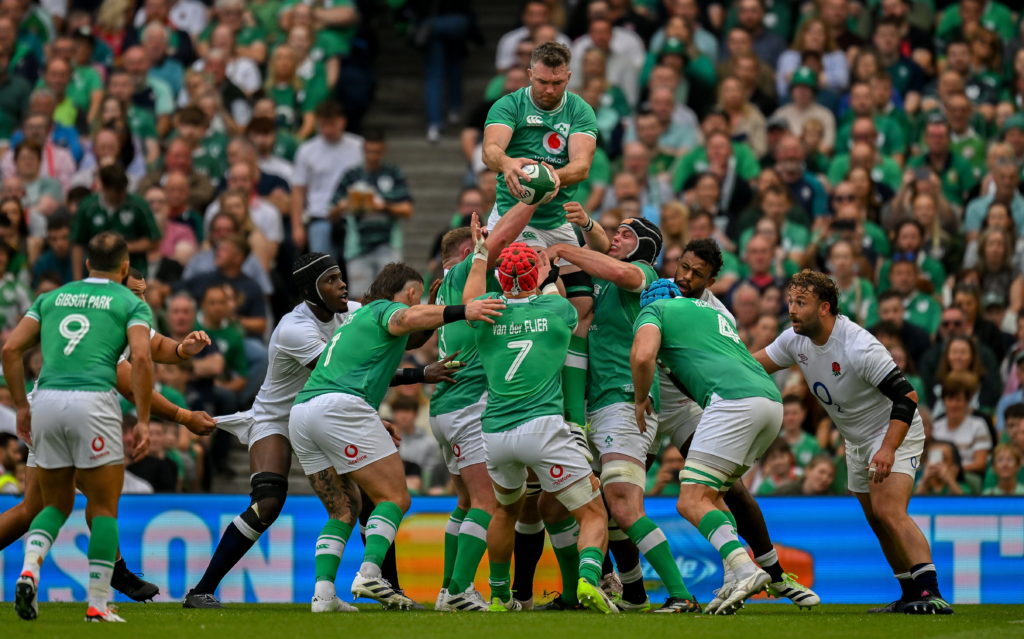 BUSY DAY AT THE OFFICE Peter O'Mahony gainfully employed tearing the English defence apart (Brendan Moran/Sportsfile via Getty Images).jpeg
BUSY DAY AT THE OFFICE Peter O'Mahony gainfully employed tearing the English defence apart (Brendan Moran/Sportsfile via Getty Images).jpegRUGBY, that curious shotgun wedding between artistry, brute force and petty laws, is not necessarily something that all Irish Post readers are experts on. But with the Rugby Union World Cup just days away, you’ll undoubtedly want to be able to hold your own in any conversations about the world of rucking and rolling.
Even if you vaguely thought that an up-and-under might be some sort of medical procedure, or are unaware that a second-row forward’s most priceless asset is a big backside — please keep reading. You never know: we might, ahem, convert you.
The game
Firstly there are two codes of rugby. One, called rugby league features thirteen men, no lineouts (see below under ‘ballet dancing and body mass index’) and is largely confined to Australia, New Zealand, Northern England, Tonga, Papua New Guinea and France. This is probably one of the very few instances where these geographical areas occur in the same sentence. Interesting though that is, it is not rugby league which concerns us here. The World Cup, which kicks off on September 8 in Paris, concentrates solely on the other code — rugby union which has a much wider international spread. This game, invented at Rugby school in Warwickshire, UK, features 15 players a side.
 FLYING WINGER: Keith Earls scores against England (picture by Brendan Moran/Sportsfile via Getty Images)
FLYING WINGER: Keith Earls scores against England (picture by Brendan Moran/Sportsfile via Getty Images)Tries, conversions and drop kicks
In rugby you score by kicking the ball over the H-shaped posts (by penalty place kick or drop kick), or touching the ball down over the try line.
That part is simple. But rugby is a complicated game, with many regulations. In a recent study, a large percentage of professional players said that they did not fully understand all the rules of the game. So don’t worry too much if you find the finer points of the game beyond your grasp. The basic rules are: (a) The ball can be kicked in any direction, but only thrown or passed backwards; (b) you cannot be involved in the play if you’re ahead of anybody on your side in possession of the ball.
To the casual observer there are some anomalies. Within the laws of the game, it may seem, you and your team-mates can attempt to gouge the ball out of the hands of your opponent in scenes that are more reminiscent of a brawl in a pub car park than an international sport. But do anything as dastardly as fumble the ball when it’s passed to you, and you’ll be penalised.
The equipment
Rugby is played, goes the old joke, by men with odd-shaped balls. No, it’s not a very good joke. But the fact that some rugby fans still trot it out gives you an idea how old some of the venerable traditions of the game are. It is also, it would have to be said, accurate. Just as in rugby league and Australian Rules football, the ball is oval. This gives it certain aerodynamic qualities, but also lends a degree of unpredictability to the bounce. It adds to the excitement.
 GOING THROUGH:Johnny Sexton thundering through the Welsh defence in 2022 (photo by David Fitzgerald/Sportsfile via Getty Images).jpg
GOING THROUGH:Johnny Sexton thundering through the Welsh defence in 2022 (photo by David Fitzgerald/Sportsfile via Getty Images).jpgThe personnel
A rugby team consists of eight forwards (the pack) and seven backs.
— THE FORWARDS are usually formidably large, tough-looking individuals with flat noses and missing teeth. In days gone by they were picked purely for their weight, physical prowess and ability to intimidate the opposition. And that was just women’s rugby. Today that has all changed.
As soon as a forward gets his boots on and laced up the mental challenge for the day is over. This is what used to be said. It is, of course, no longer the case, with international forwards having a very keen sense of tactics — even though it’s possible for a forward to go through an entire match only rucking and mauling, and never actually touching the ball.
— THE BACKS, despite their name, do the lion’s share of the attacking. Forwards, they say, decide who wins a match; backs decide by how much.
The Ireland team have some exceptional backs including Hugo Keenan and Keith Earls. When Earls is at full tilt towards the opposition try-line it would be fair to say he’d contravene the speed limit in most built-up areas.
— THE OUT HALF: Pivotal to the entire team is the out half, sometimes called the No. 10 sometimes the standoff, who coordinates the play between the forwards and the backs. Johnny Sexton is widely regarded as just about the best in the world. But Ireland has always been well supplied with No. 10s — Sexton took over from the equally highly rated Ronan O’Gara.
Going back to the 1970s, a titanic struggle was played out between the two standoffs Ollie Campbell and Tony Ward. So transfixed was the nation in 1978 when Campbell was picked ahead of Ward, that a national newspaper ran the splash headline “Ward out Campbell in”. Underneath, in much smaller print was a headline “Pope John Paul II to visit Ireland next September”.
 GETTING THE JUMP ON THE OPPOSITION: An Irish lineout against England (picture by Brendan Moran/Sportsfile via Getty Images).jpeg
GETTING THE JUMP ON THE OPPOSITION: An Irish lineout against England (picture by Brendan Moran/Sportsfile via Getty Images).jpegJumping for victory
This is rugby union's answer to football's throw-in, but is vastly more entertaining. The forwards line up where the ball has gone out of play, and the ball is thrown in. Thereafter unfolds one of rugby’s more arcane spectacles. One player is usually elected to jump for the ball — he can be heaved into the air by his fellow forwards. Thus you have the sight of a huge forward reaching some ten feet in the air supported by his comrades. This is probably the closest that men with ludicrously high body mass indexes come to performing an arabesque or a grande gargouillade from The Nutcracker Suite. On second thoughts ‘nutcracker’ probably isn't the best ballet to think of. See below.
Peter Mahony, standing at 6ft 3ins is by no means the tallest international player, but he is one of the stars of the Irish lineout. Ireland’s success could well depend on how well he’s hoisted into the air by his team-mates
Top of the props
The origins of the word scrum are mediaeval – from scrum to scrummage, thence to scrimmage and as far back to skirmish in the 15th century. Indeed, a scrum can sometimes resemble mediaeval conflict. After the two sets of forwards, with arms like JCB jibs, have wrestled each other to the ground in search of the ball, it can seem entirely reasonable to expect a wooden cart to trundle onto the pitch to collect limbs and body parts.
In a scrum, the 16 forwards bind together in a crouched huddle to settle an infringement of the laws. The prop forwards on each side are the interface between the two teams. They wrestle with each other, push against each other, probably say naughty words, while the two hookers (please, every conceivable joke has already been made) square up to each other and attempt to win the ball with their feet. Weight and low centre of gravity are paramount in the scrum — hence a large arse is a prized possession for forwards in the middle of this mass of flesh.
Ireland’s scrum currently is as steady and immovable as the Rock of Cashel. Tadhg Beirne at the back of the scrum could send out for a pizza and have it delivered for the lads up front.
Ruck & roll
The ruck and the maul are the parts of the rugby match which often seem in danger of spiralling out of control and into something resembling an inner city street fight. Both occur after a tackle — a ruck occurs when the ball carrier falls to the ground; a maul when the ball carrier remains upright. Different rules apply.
Both sets of forwards grapple and grasp for the ball — and, to tell the truth, grapple and grasp for parts of the body belonging to opposition forwards.
Recently a Scottish rugby player described his most terrifying moment in a match. In the confusion of a maul during an international with Ireland, the Scottish forward managed to bite Willie John McBride, a one-man wrecking ball, and one time captain of Ireland as well as the British and Irish Lions. In a line-out a few minutes later, the Scotsman suffered the sheer terror of Willie John sidling up to him and whispering in his ear in his broad Ulster accent, “I know it was you...”
This is the sort of thing that goes in a maul.
But today head injuries are treated seriously. There’s story about Bill Shankly, the Liverpool manager — we’re talking soccer here, not rugby — and his attitude to injuries. After one player was injured — in the days before substitutes were allowed — Shanks was told by one of his medical staff, “He’ll have to come off. He doesn’t even know what his name is. Shankly replied, “Ach, just tell him he’s Pele and keep him on.”
Today, that sort of thing would not be allowed in rugby.
In modern times soccer is basically 90 minutes of pretending you’re hurt. Rugby is 80 minutes of pretending you’re not
This year’s competition
Most betting puts Ireland, New Zealand and France as the bookies' choice, with the All Blacks marginal favourites. Ireland, to date, have always choked at the big occasions, and have never progressed beyond the quarter finals. But this year could be different. As one commentator said, on seeing a fairly ragged Ireland side trounce England, “Ireland appear to have forgotten how to lose.”
But of course France have home advantage in a country where rugby is almost a religion. They even have a church window dedicated to rugby. Larrivière-Saint-Savin in the Landes department of Nouvelle-Aquitaine in south-western France has a modern stained glass windows showing the Virgin Mary surrounded by rugby players. The glass artwork shows Jesus huddled in a scrum, throwing a ball, and even depicts him as a young child clutching a rugby ball while settled in his mother’s lap. Even though rugby is mentioned nowhere in the Bible.
So France will be the one to beat — a country, especially in the southwest, that loves rugby, lives rugby, breathes rugby and lines up drop kicks in its sleep.

